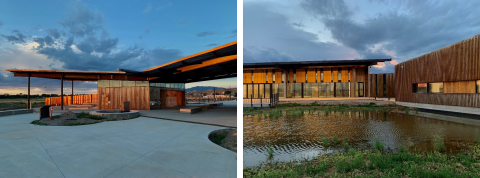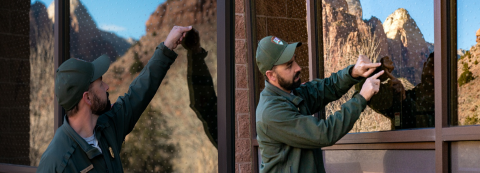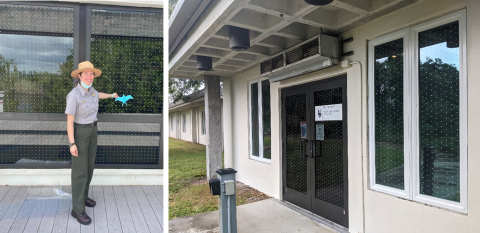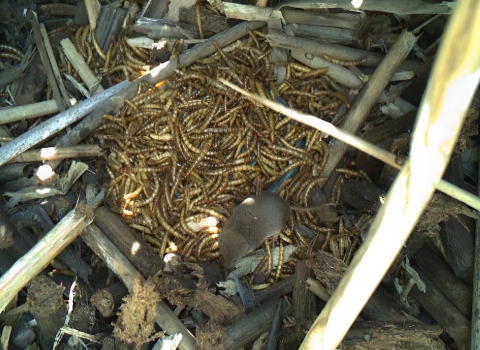The Issue
Each year, up to 1 billion birds in North America are killed in collisions with glass. Many of these collisions are with building windows, especially small buildings and low-rise residences. Window collisions are a threat to birds because they are unable to see glass and instead perceive window reflections (clouds, trees, or other habitat) as a continuation of their outdoor environment. While humans can learn to avoid glass through visual cues and context, birds are unable to use these signals. Most birds’ first experience with glass results in significant injury or death when they collide at full speed. Such collisions are especially a threat during spring and fall migration seasons when large numbers of birds are on the move. Luckily, human-caused sources of bird mortality, like collision hazards, are preventable with relatively quick and affordable solutions!
In response to this alarming issue, the U.S. Fish and Wildlife Service (USFWS) Migratory Bird Program has identified high priority actions that will have an immediate positive impact on reducing the number of bird collisions with buildings across the United States. One of the first steps has been to promote and implement bird-friendly glass treatments, facility design and construction at our buildings and with our federal partners.
USFWS Leading the Way
In 2021, the USFWS Northeast Region helped kick off this effort by starting a nationwide Bird Safe Building Survey initiative with the help of three interns from the Service’s Directorate Fellows Program. The Migratory Birds Program Collisions Team developed metrics to use the survey data to identify the highest risk Service buildings to retrofit with bird-friendly glass treatments. Since then, more than 2,300 Service buildings have been surveyed for collision risks across the country.
The Northeast Regional Office staff not-only retrofit the three stories of exterior windows at their Headquarters office in Massachusetts, but also organized and led a workshop session at Patuxent Research Refuge in Maryland to teach Service employees across the region how to retrofit their office and home windows too.
Image 2 (Center): USFWS Northeast Regional Headquarters bird-friendly glass on three story building by Mason Wheatley/USFWS
Image 3 (Right): Installing bird-friendly window treatment during the 2022 Maintenance & Managers Workshop at Patuxent Research Refuge/USFWS
The Service has also recently implemented a nationwide policy that mandates all new buildings to be bird-friendly, with the aim of stopping bird collisions at its facilities by the end of Fiscal Year 2031. Recently opened facilities, such as Valle de Oro National Wildlife Refuge visitor center and the new Tishomingo National Wildlife Refuge visitor center are examples of buildings built with bird-friendly designs from the start!
Working Across the Government
In addition to USFWS facilities jumping into the bird-safe building effort, the U.S. Forest Service and the National Park Service have also taken action. The Council for the Conservation of Migratory Birds (Council) has been a key motivator for these federal entities to collaborate as they oversee the implementation of Executive Order 13186, Responsibilities of Federal Agencies to Protect Migratory Birds.
Teamwork between U.S. Fish and Wildlife Service & the U.S. Forest Service
The U.S. Forest Service’s (USFS) Northern Great Lakes Visitor Center in Ashland, WI, installed glass treatments last summer in partnership with Whittlesey Creek National Wildlife Refuge. This was one of several projects that was selected for financial support through the Migratory Bird Program’s annual “Bird Friendly Challenge,” a cost-share program for reducing impacts to birds in USFWS Midwest Region.
The U.S. Forest Service (USFS) Alaska Juneau Ranger District retrofit Tongass National Forest recreation cabins in 2021 and 2022. Juneau Ranger District Wildlife Technician Gwen Baluss developed and implemented this project. Windows were treated at five of the public remote wilderness recreation cabins. A public information flyer was also produced and displayed to educate cabin visitors about forest bird habitat, collisions, and methods for reducing impacts.
The National Park Service (NPS) recently installed glass treatments at Zion National Park and the Ernest F. Coe Visitor Center for Everglades National Park.
Method
Most of these glass retrofit examples utilized dot pattern window markers. The DIY rolls are placed on the outside surface of a window to make the glass area more visible to birds while remaining unobtrusive to humans. This easy-to-use method can be suitable and economical for most building types.
Beyond dot decals, there are many other options for treating glass to be more bird friendly. Other methods include applying external tinted films, hanging parachute cord curtains, installing screens, or even replacing regular glass windows with new glass that is ultraviolet patterned, etched, or frosted on the outside. For a temporary solution, non-toxic tempura paint can be used to get creative and paint pictures, draw, or even cover the entire window with a mural!
A few aspects to keep in mind for effective bird-friendly window treatments:
- For vertical stripes or patterns, use spacing at 2 inches by 4 inches or smaller to account for hummingbirds
- Dark colored patterns may be difficult for birds to see if dark colors reflect on the glass
- Patterns applied to the outside of windows will prevent more bird collisions than inside
- Turning off unneeded lights can help lessen attraction to your windows, especially during spring and fall migration seasons
Making an Impact for Birds
By incorporating these best practices into building, maintenance, and renovation, federal agencies are taking measurable steps to reduce bird collisions across the United States, which will reduce one of the leading causes of bird mortality. However, solving a problem of this size requires collective action, so join us in the nationwide effort to reduce bird collisions!
Learn more about which methods you can use for bird-safe window retrofits at your home, school, business, or other glass structures that may pose collision hazards. We can all help to greatly reduce the risk of collisions and help protect migratory bird populations. By working together, we can accomplish even more!
Join the flock and help Bring Birds Back with a more #BirdFriendly community!
BIRD-FRIENDLY BUILDING TOOLKIT
BIRD-FRIENDLY UNIVERSITY TOOLKIT
BIRD-FRIENDLY COMMUNICATION TOWER TOOLKIT
DEVELOPING A BIRD-GLASS COLLISION MONITORING PROGRAM
Please note: these toolkits are in development and continuously updated as new resources become available!
Additional Resources
- Decline of the North American Avifauna, Rosenberg et al.
- Best Practices to Reduce Bird Collisions with Buildings
- Reducing Bird Collisions with Buildings and Building Glass
- American Bird Conservancy’s Products & Solutions Database
- 3 billion bird initiative
Share information and your efforts to help prevent bird collisions with colleagues, friends, and families with #3billionbirds #birdcollisions on social media!











